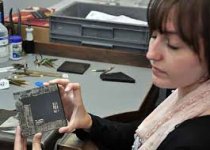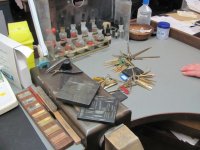OOOOhhh now I get it...I was not even thinking about 10K. Guess its good to get a set of test needles to compare as I don;t want to keep scratching my good plat...
I did not test it again yet. sort of just trying to regroup...I did test it twice already. Nor sure why it looked like it failed the 2nd test...
It did though as I took pictures....That is really ... Still driving myself crazy is not good either...I looked at it under 20X mag. Really looks like the scores on the side of the screw were handmade. Why would someone hand finish fake platinum?> I should order the test tube...ack graduated cylinder. I found a 5ml class A for $9 shipped so its worth it to try to do a SG test.
Played a bit more...gosh whatever it is is slowly being worn away...
Thinking it could be palladium too. Seems to hold a short while w plat acid then spreads & fades. Maybe tiny bit of line remains.. It holds better to 18K & does not seem to bronze though so hope its not that.
Palladium also hold a short while to plat acid but disappears...18 K seems to turn palladium into a oily sludge. Not sure how to deal with palladium but have 2 mountings from stuller.
This guy thought he had plat, as it resisted plat & 18K acids/ Turns put it was 58 %cobalt, 35% nickel with a 7 % copper. It seems it might be a bit harder than plat.
http://www.findmall.com/read.php?91,1906128
This stinks...well he said he smells metals....sort of smells like my gold...oh no,,,my plat irid smells sweet...
Yikes I think I can smell a difference....My plat 950 smells more like it...seems irid gives it a different smell...hmmmm or I need sleep & thi is driving me mad!!!


